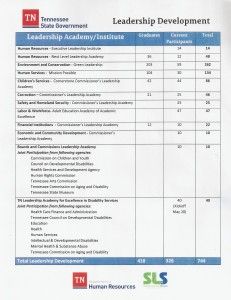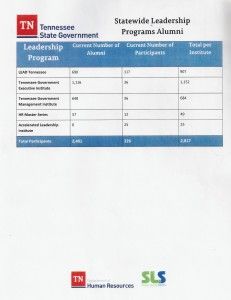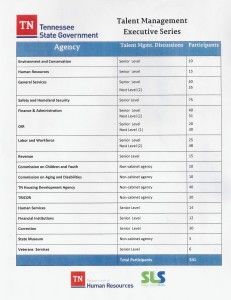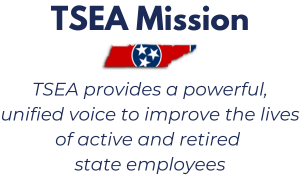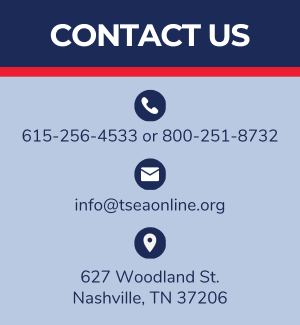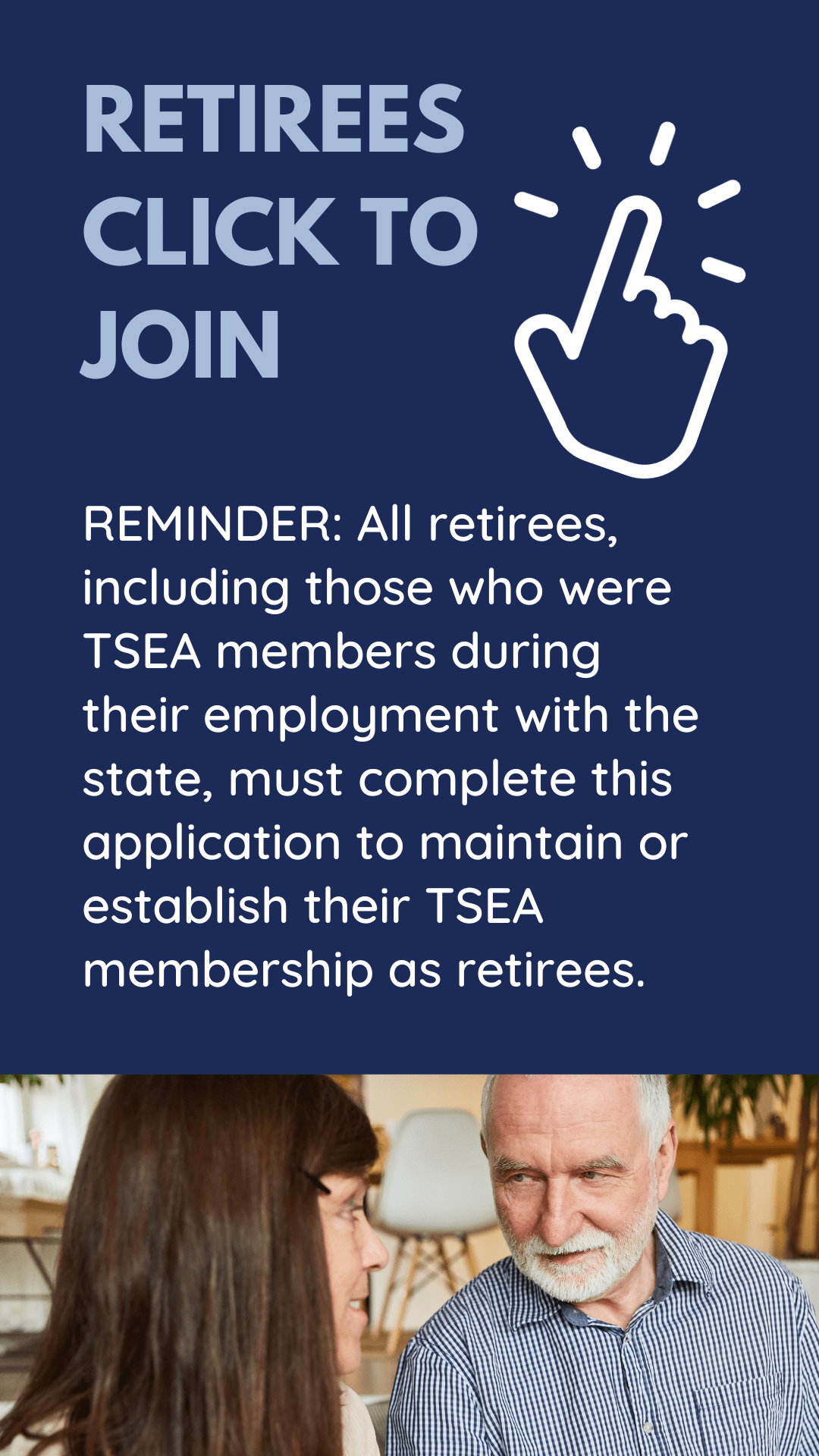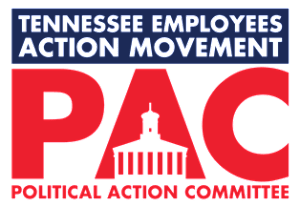On efforts to increase employee pay, the recent comptroller’s audit of DOHR, and her passion for service.
 by Chris Dauphin, TSEA Communications Director
by Chris Dauphin, TSEA Communications Director
and Gayle Robb, TSEA Comp & Benefits Manager
Tennessee Department of Human Resources Commissioner Rebecca Hunter came to state government in 2011 as a part of the administration built by then newly elected Governor Bill Haslam. Hunter, a CPA who worked in public finance for over 25 years, refers to herself as a “recovering accountant.” In 2004 she took over the Hamilton County personnel department, where she was employed until her appointment to state government. Her entire career has been in the public sector, to which Hunter credits a passion for service.
On the heels of the largest state employee pay raise awarded under the Haslam administration, and just days after a budget was approved by the legislature which includes what will likely be the largest pay raise state workers have received in a decade, Commissioner Hunter sat down with TSEA to discuss efforts to increase employee pay, the recent comptroller’s audit of her department, and her passion for service.
DOHR Deputy Commissioner and General Counsel Danielle Barnes also joined us for the interview, providing important data and specifics throughout our discussion.
Employees in Jan. received their largest raise since July 2012, and some employees just received market adjustments in March, can you talk about those?
Commissioner Hunter: Our governor is committed to making sure that we can recruit, retain, and reward a talented workforce. He has continued [raises] with each budget, and if you recall the year we didn’t receive raises, they started off in the budget but were removed. Haslam said that was one of the toughest things he’s had to do was take those out. But January 2016 was the largest raise we’ve had since 2013. These raises were also the first time we’ve paid for performance.
When I first came on board in 2011, the Deputy Governor and I went on a state-wide employee listening tour. We went to all the major cities and had two daily sessions with state employees. Our goal was simply to ask their ideas on how to recruit, retain and reward a talented workforce. One of the things we heard from these sessions were employees expressing frustration regarding pay. And some of the employees expressed frustration that another employee sitting beside them was not at all productive, yet both employees were receiving the exact same raise.
We were excited about pay-for-performance because we didn’t get the idea in a vacuum, we sent out a survey. We pulled together a task force from people who responded to the survey and got their input and feedback before we moved forward with the design.
The performance raises in January were from a pool of $26.9M. If you look at the appropriations bill, it stipulated that the funds would be used for pay-for-performance, market adjustments, and range adjustments.
The market adjustment that occurred in March was to move all the ranges 1 percent. When you move the ranges 1 percent, you are typically going to have people that then fall below the minimum of those ranges. So, our goal was to make sure we had the funding to also adjust anyone who fell below the minimum of the range and move that individual to the new minimum.
There was just a little funding left, which was used to continue to move people towards market. We moved the people who were the closest to the minimum range based on a formula using the funds that were remaining.
How many were moved towards the mid-range?
Danielle Barnes: 3,112
Pay for performance (P4P) raises which state employees received in Jan. were allocated from a revenue pool of $26.9M. This year’s budget includes twice that amount (appx. $60M) for next year’s raises. What do you expect the raise percentage amounts will be for FY2016/2017?
Commissioner Hunter: As you know, it is based on ratings. I wouldn’t want to try and guess that amount. But, keep in mind, it equates to a 4 percent pool of funds. But, once you start allocating based on performance ratings, if you think about it, what people ended up with in January was 2.5, 3, and 4 percent out of a 2 percent pool. So, clearly what that says to me is I think we are going to be in a better position this coming year than we were this past time.
Hopefully some of those who were at the valued rating will bump up to advanced.
Commissioner Hunter: Right. Our goal is to always coach towards higher performance, so that is the unknown, we don’t know who will move from valued to advanced, and who will move from advanced to outstanding.
Valued had the largest percentage of state employees this past period, correct?
Commissioner Hunter: Yes.
But, that won’t be the case this year, right? Hopefully the largest category will be advanced or outstanding.
Commissioner Hunter: Well, keep in mind what the term valued reflects. It means the employee is doing the job he/she was hired to do. With all of the research we’ve done, no matter what company you’re talking about, that’s where the bulk of your people are going to fall. They say, “I am doing the job I was hired to do.” And then you are always going to have those that say, “I’ve finished my work, what can I do beyond this.” So, it’s difficult to know who those people are, who would move to advanced and outstanding. But the goal is always to coach to higher performance.
Will all future P4P be paid in January, if funds are available?
Commissioner Hunter: We can’t guarantee it, but it makes sense because the cycle ends Sept. 30. And that is why we chose January, to give us time. Not everybody is going to have everything entered in by Sept. 30, because some people are out on vacation, some people are out on leave, so our challenge is making sure that everyone who should be getting a rating receives a rating.
Then, once we know the ratings, we look at what that does to the pool of funds. Then we do the system work that is needed to get everything entered for pay. You’ve got the performance piece over here, and you’ve got the pay piece over there, and you’ve got to get those aligned, which takes time. So, I would say based on that, based on experience and our recommendation, January makes sense. But it all depends on how the funding is established and all of that.
If an employee is hired on October 25, and consistently does their job well enough to be considered valued, since Sept. 30 is the established eligibility date and by statute they must be employed for a year to receive a rating, they wouldn’t be eligible for a performance rating for almost two years. Does that mean, this employee would have to wait up to 27-28 months before they see a pay raise?
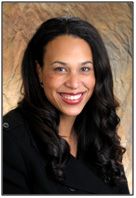 Danielle Barnes: We had to select a date in time where we said this is the date when your eligibility is determined. And that date is the end of the cycle, which is September 30. But, those employees would qualify for a market adjustment.
Danielle Barnes: We had to select a date in time where we said this is the date when your eligibility is determined. And that date is the end of the cycle, which is September 30. But, those employees would qualify for a market adjustment.
Some employees may not have met the 12-month requirement, but we don’t want them to fall behind and lag in the market, so that is why the market adjustments come right behind them. Those folks who have been here less than a year, they are going to be sitting at the bottom of their salary range. The goal is to continue to move them through the range towards market so they don’t get to a point where they are lagging behind other employees.
Commissioner Hunter: And there is not a time stipulation on the market adjustments. An employee does not have to work for the State for any certain amount of time for a market adjustment.
Is everyone hired in at the minimum of their position’s range?
Commissioner Hunter: Not everybody. It really depends on the position. In order to be hired above the minimum, there has to be adequate justification.
So if I understand you correctly, the system is set up with the intention to catch everybody?
Commissioner Hunter: Yes.
Danielle Barnes: With something.
Speaking of market adjustments, there has been a total of $36M set aside in the budget for them, can you talk about those?
Commissioner Hunter: What we were hoping to do, just as we did back in 2013 when we did market adjustments, is to try to impact the largest number of employees. When we looked at the database of salaries, what we realized was we could have a huge impact if we targeted those employees whose salary is $50K or less. And it’s about approximately 25,000 employees who will receive a market adjustment.
When should these employees expect to see the market adjustment?
Commissioner Hunter: It is effective July 1, 2016 – which means employees will see the adjustment on their July 29 paycheck.
Comptroller Audit
Included in a response from the department to the Comptroller’s audit, it was stated that 2 percent of employees received a rating of “Outstanding” this cycle; What percentage of “outstanding” ratings, on average, do you expect to see in a typical cycle?
Commissioner Hunter: What you have to take into consideration with state government is what a culture change it is. When I first came on board in 2011, I was stunned to find out that 85 percent of state employees were rated as 4’s and 5’s. I knew that was not the norm based on my experience. But once I did the research, what I found is we had actually been coaching supervisors to write the performance plans to be a stretch. But when you actually audited those performance plans, they didn’t know how to write them to be a stretch. Because most managers know what they hired you to do, and that is how they were writing them. So, of course, once the manager starts evaluating the employees, the managers gave the employees those higher ratings because that is how the plans were written. And so we really knew we needed a massive culture change.
When you have a five tier scale like that, research indicates it gives managers more flexibility. But we knew a lot of people look at a “3” as average, middle of the road. And we knew, from research, that is where the majority of employees always land, regardless of whether it is the private or public sector. And we knew we needed to send a different message. So, we put a lot of thought into what we could call that middle tier that would let employees know it was a good thing, and that is how we came up with “valued”. You want people to do that job they were hired to do, and they are considered valued when they are doing that.
We also knew when we moved toward pay-for-performance that if we were really serious about it we couldn’t be recognizing people who had unacceptable or marginal ratings. Now, keep in mind, they would still be eligible for market increases because, again, our goal is to keep salaries as competitive as possible.
And we wanted to be clear about what it took to get to that advanced level, and what it took to get to outstanding. When you look historically at how we coached supervisors, and what we learned about that, we realized that they actually needed help in coaching employees to higher performance. We would have employees tell us, “My supervisor doesn’t know what to tell me when I ask ‘what do I have to do to get to advanced or outstanding?” You don’t want it to be prescriptive. If you think about it, when you’ve supervised employees you don’t want to have to be always telling the employee what to do. You want that employee to be creative and to say, “hey, I have done this, how about I do this.” You really want to drive creativity and innovation. If you are telling them what they have to do to get to advanced and outstanding, that defeats the purpose of having an engaged workforce that is really contributing to making the processes better.
Knowing that, we realized that we needed to equip the supervisors to do so, and that is what the Get S.M.A.R.T.er initiative was this past summer. We are really proud of it. We trained 8,000 supervisors across the state. We trained them on how to coach employees to higher performance. We even brought in outside coaches to assist us with that effort, because it was such a herculean task. The outside coaches shared with us that they were really proud to know that their state government cares about its supervisors and employees.
Ultimately, what you are trying to do is create a culture of continuous feedback so that employees come to work excited about the work that they do and are coming up with ideas to make things better.
DOHR’s performance management workflow only requires the appointing authority’s approval/denial for unacceptable and outstanding ratings. Was there any thought to include marginal in that appointing authority level review, considering a marginal rating would prevent an employee from receiving a pay raise?
Danielle Barnes: Our research indicates you need that approval for that top layer and that very bottom layer because we want to keep honesty and integrity on both the top and on the bottom end. What we encourage folks to do, is to do another review. The way that our performance management process is set up is to build in integrity so you’ve got the supervisor giving the rating and then you have a reviewer who actually looks at the rating, so that is two layers of review to make sure that everything is being explained properly and to make sure that rating is appropriate. So, that is the way the system was built all the way around. It is not just on that top and bottom, but all the way throughout.
We do have some agencies that are taking an extra step where if you are making an advanced or a marginal, you get another layer of review. Not necessarily the commissioner, but maybe the deputy commissioner or the assistant commissioner over that area.
Commissioner Hunter: When we talked about trying to make the process as objective as possible, we realized we needed to change the culture. That first piece was going from the numerical ratings to the defined “unacceptable”, “marginal”, “valued”, “advanced” and “outstanding” ratings.
Part two of that was, to offset the possibility that a supervisor may be biased towards an employee, have that next level up review the rating. Danielle reports directly to me, but I review everybody who is on her team and it is the same for each of my direct reports. And what that gives me is that broader look across the enterprise. Plus, as Commissioner, I am also seeing anyone on the team who got an outstanding or an unacceptable.
We have commissioners who will look from a broad perspective across their enterprise at the ratings and maybe they might have more marginals than anywhere else and ask, is there a trend going on there. I am beginning to see cabinet members getting more sophisticated about looking at approaching from a continuous improvement perspective and how we can make it better each time.
What we are really trying to encourage supervisors to do is to help them differentiate their employees. The very first time I was introduced to a performance-based pay plan, the way it was explained to me was, if you were a firefighter, and you showed up at the house that was on fire, and it was your house, and you knew your children were in there, you’d be thinking about which two fireman you’d be taking in there with you to rescue those two children. We all know that the research says that the bulk of your team is going to be valued. And you are going to have some that you’re always going to have to be coaching to try to get them to that higher performance, but then you are going to have your high performers. And so it’s really about differentiating your team. It reminds me of when we were on those listening tours where people said, “I really don’t like it when they treat us all the same when it is obvious to me that I am the one going above and beyond all the time, but I’m not being appropriately compensated for it.”
What would someone who fills potholes need to do to earn an outstanding rating?
Commissioner Hunter: What you are talking about is the jobs that are critical to the mission. If we didn’t have people out there filling potholes, TDOT would be in serious trouble. Here is my philosophy on that. What you are looking for are the ones who differentiate themselves. I can’t speak to potholes because that is not my expertise, but using my background, I started my working career as a secretary. I always looked to try and make the letters that were dictated to me as professional as possible. I would come back with suggestions and they’d say, “oh, I really like that”, so it’s really just helping employees understand that we value their ideas and we value their input. Because, it’s the frontline employees that typically know how to make things better, and we are looking for that employee that isn’t just going through the motions of their daily job, but actually thinking about ways we can make things better.
We are also challenged by the fact that some supervisors resent this. So we’ve got to work with that as well and have supervisors open to employee ideas.
What are the pay-for-performance system’s strengths and weaknesses?
Commissioner Hunter: We really needed to do a reset when it came to performance management, because they weren’t being completed timely, a lot of them weren’t being completed. And, recognizing that the purpose of it was first to set expectations. As an employee, you want to know what you were hired to do. Employees don’t come to work anywhere with the expectation of disappointing their supervisor or failing. They want to come in and do the best job that they can possibly do. And, in order to do that, we have to set the expectations for them.
What I love about this system is it requires, at a minimum, four conversations with each employee. The goal is for the supervisor and that employee to sit down on the front end and talk about what the expectations are and make sure the employee fully understands what is needed to get there. And those [goals] have to be S.M.A.R.T.
When that first interim comes around, then what you are talking about is how has it been, how can I help you, what barriers have you achieved.
That is another thing of which I am really proud. We are trying to equip supervisors for those conversations. If you think about it, most supervisors dread performance evaluations.
If you are having those conversations, it’s not a surprise. The employee knows what’s expected, and once you get to that rating you have a really good feel for what it is going to look like. So, you start off with that preliminary discussion, setting those expectations, making sure that employee understands. Then you have those two interim discussions to make sure they are on target, and then by the time you get to that rating, there are no surprises.
I know that takes time because it is new, it is a culture change. But, between the performance coaching and the Get S.M.A.R.T.er, and making sure that the performance plans are objective, we really feel that we’ve made great progress towards creating a culture of continuous feedback focused on employee success.
The Comptroller’s report said there are instances where a supervisor change could affect an employee’s eligibility for a salary increase, e.g. if an employee’s supervisor changed with less than 90 days until the end of the evaluation period. Could this happen? If so, what options would those employees have to ensure they did not become ineligible for a salary increase?
Commissioner Hunter: In that case, we would revert back to the rating from the previous cycle so they would be eligible for the raise, and there are examples where it has reverted back to valued. The default is valued.
Is DOHR looking to make changes to – or end – the SLB? And/or are there plans being considered that would impact the annual and sick days employees currently receive?
Commissioner Hunter: I have a great network of peers across the country, and we meet twice a year to exchange ideas. I learned through those meetings that there are only about five states in the country that have a sick leave bank. Most states are actually utilizing short term disability. I sat at the last insurance committee meeting and listened to [Benefits Administration] describing the advantages of short term disability and that it covered certain things that the sick leave back doesn’t. We’re always thinking about ways to make things better. There are no immediate plans to do anything like that because, believe me, I have my hands full right now. But, when you look at the statistics, I don’t think the employees get the return on investment that they could [with short term disability].
Do you think employees benefit from the SLB?
Commissioner Hunter: I can get you the statistics, but what surprised me was how few employees take advantage of it.
Wouldn’t it be the same way if there was a short term disability, only those who needed it would use it?
Commissioner Hunter: At the insurance committee meeting I was really surprised, especially after just having the audit, at all of the things [Benefits Administration] shared that short term disability would cover that the sick leave bank doesn’t.
I think it would be helpful to put the statistics in there, because we don’t do that. That’s not something the employees are aware of, and if I were investing my money into the sick leave bank, I would want to know what my return was on that.
As the Commissioner of Human Resources, you are an advocate both for the public policies of the Governor, as well for the employees who work for Tennessee. How do you balance the needs of both parties?
Commissioner Hunter: I have the privilege of working for a Governor who always asks, “what is the right thing to do?” And knowing that is how he approaches his work is tremendously encouraging. I think the one thing that we all need to remember is, the Department can’t just look only through the lens of the employee. It is not that simple. In my role, I can’t look just through the lens of the employee. I have to look at the cost, the impact on the citizens, and it is a balancing act. And the rewarding part of it is trying to get it to where it’s a win-win for both parties.
If you’ve built those relationships, and the employees know that you have their best interests at heart, they may not always agree with every decision that is made, but they understand that you are trying to do what’s right for all parties concerned. Budget is always a concern, knowing what the Governor’s priorities are is always a concern, and keeping in mind that the citizens are the ones paying for all of this. We can’t always do everything we would like to do because of the different constraints, but my goal is always to make sure everything we do is from a fair and equitable perspective so employees know that we do have their best interests at heart.
(At this point, we briefly discussed the governor’s Outsourcing plan, and our belief that state employees should be cross trained for the work instead of outsourcing their jobs. DOHR listened, but reminded us that they are not over Higher-Ed).
Commissioner Hunter: This is a good segue into some of the great work our team is doing. I am a lifelong learner and am passionate about employee development. Ever since Governor Haslam came on board, he’s empowered me to put a focus on employee development.
(Here Commissioner Hunter handed us a 40-page magazine style pamphlet of their enterprise-wide leadership programs, which includes much of the information available online at http://tn.gov/hr/section/learning-development).
I want to draw your attention to the Management and Leadership Learning Pyramid. It is focused on supervisors, but if you look at level 1 you’ll see that there is curriculum there for employees who aren’t supervisors, but are considering becoming supervisors. We don’t say you have to be a supervisor in order to take them. In order for employees to be successful, their supervisors need to be the best they can be. So, we’ve really put a big focus on developing supervisors and managers.
We have also reached out across the enterprise to host leadership academies with agencies as the need arises. For example, back in the fall of 2011 when we were accepting applications for LEAD Tennessee, which is the State’s premier development initiative that accepts both current and emerging leaders (you don’t have to be a supervisor to be in it), we had nine applications for two slots. I was excited on the one hand, because we had that many people showing interest, but sad that I was going to have to send so many “sorry” letters back to our employees. Trish Holliday, who is the Chief Learning Officer, said our department could just start our own leadership academy. So we did and we called it the Next Level Leadership Academy.
It is really like a mini LEAD Tennessee. It’s based on the Jim Collins Good to Great principles. We accept 12 applications, and I think we had 15 that first year. Six months in we were hearing from supervisors, peers, and fellow employees who were saying, “wow, what are you all doing with these people,” because they could tell a difference in their whole approach to their work. And from my perspective it was that they knew that we cared enough about them to invest in them and help them to grow and develop.
We are in our fourth year right now. We had 22 applications this year for 12 slots. Each year it is even more competitive. So, that was the model, and we’ve now rolled that out across the enterprise. There are several different agencies that are hosting leadership academies. Some of them, like us, are on their second and third years.
(At this time Commissioner Hunter shared data showing the various state-wide leadership programs they are driving across the enterprise, with corresponding participation levels.)
Because the economy has picked up, we are beginning to see people who feel a little more comfortable about retiring, so retirement is up. But we are also seeing applications decrease because it’s more competitive. When the economy was not in a stable place, people knew government was solid because most governments don’t go bankrupt. So, for several years, we have really put a focus on workforce and succession planning.
(Commissioner Hunter gave us a list of agencies who have gone through the Talent Management Executive Series in order to do the workforce succession planning).
The leadership teams go through this, and it really equips them to identify where there are gaps, and make sure people are being developed to step into those roles. We don’t develop a person; we develop a pool of talent because, as you know, we make our application process as competitive as can be. We’re really proud of the work we are doing to equip employees to be successful, to develop them for these roles. Like our Next Level Leadership Academy, we have both supervisors and front line employees who enroll in that. They approach it from the perspective that they are hungry to learn and grow. It is really to help them become better leaders. We talk about how you can lead no matter where you are, that you don’t have to have manager or supervisor in your title to be a leader. You can influence from wherever you are.
Everywhere I go, I hear employees who say how much it means to them that we are investing in them. Companies that don’t invest in their employees don’t have happy employees.
What I am most proud of is the work we are doing giving supervisors the tools they need to be better supervisors. This allows supervisors to help the employees be better and provides development opportunities across the state, regardless of the level, so that we’re positioned to better serve our taxpayers.


